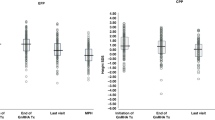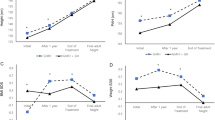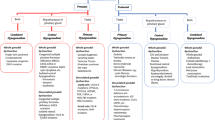Key Points
-
Puberty suppression using gonadotropin-releasing hormone analogues is prescribed to relieve the distress associated with pubertal development in adolescents with gender dysphoria, in order to provide time for further exploration
-
Treating prepubertal individuals with gender dysphoria is particularly controversial owing to their unstable pattern of gender variance compared with gender-dysphoric adolescents and adults
-
The absence of robust data in support of or against the use of puberty suppression in childhood-onset gender dysphoria has led to inconsistencies between health-care pathways across different centres
-
The paucity of evidence of the effect of puberty suppression on health-related outcome measures calls for studies that might help to advance the evidence-based debate on risks and benefits
-
Despite a limited number of studies, the existing literature supports puberty suppression as an early, sufficiently safe, and preventive treatment for gender dysphoria in childhood and adolescence
Abstract
Puberty suppression using gonadotropin-releasing-hormone analogues (GnRHa) has become increasingly accepted as an intervention during the early stages of puberty (Tanner stage 2–3) in individuals with clear signs of childhood-onset gender dysphoria. However, lowering the age threshold for using medical intervention for children with gender dysphoria is still a matter of contention, and is more controversial than treating the condition in adolescents and adults, as children with gender dysphoria are more likely to express an unstable pattern of gender variance. Furthermore, concerns have been expressed regarding the risks of puberty suppression, which are poorly understood, and the child's ability to make decisions and provide informed consent. However, even if the limited data available mean that it is not possible to make a conclusive treatment recommendation, some safety criteria for puberty suppression can be identified and applied.
This is a preview of subscription content, access via your institution
Access options
Subscribe to this journal
Receive 12 print issues and online access
$209.00 per year
only $17.42 per issue
Buy this article
- Purchase on Springer Link
- Instant access to full article PDF
Prices may be subject to local taxes which are calculated during checkout

Similar content being viewed by others
References
Sohn, M. & Bosinski, H. A. Gender identity disorders: diagnostic and surgical aspects. J. Sex. Med. 4, 1193–1207 (2007).
Benjamin, H. The Transsexual Phenomenon (Julian Press, 1966).
Coleman, E. et al. Standards of care (SOC) for the health of transsexual, transgender, and gender nonconforming people, 7th version. Int. J. Transgenderism 13, 165–232 (2012).
Hidalgo, M. A. et al. The gender affirmative model: what we know and what we aim to learn. Hum. Dev. 56, 285–290 (2013).
American Psychiatric Association. Quick Reference to the Diagnostic Criteria From DSM-III (American Psychiatric Association, 1980).
American Psychiatric Association. Diagnostic Criteria From DSM-IV (American Psychiatric Association, 1994).
American Psychiatric Association. Diagnostic Criteria From DSM-IV-TR (American Psychiatric Association, 2000).
American Psychiatric Association. Desk Reference to the Diagnostic Criteria From DSM-5 (American Psychiatric Association, 2013).
Drescher, J. Queer diagnoses: parallels and contrasts in the history of homosexuality, gender variance, and the diagnostic and statistical manual. Arch. Sex. Behav. 39, 427–460 (2010).
Money, J. & Tucker, P. Sexual Signatures: On Being a Man or a Woman (Little Brown & Co., 1975).
Fagot, B. L. & Leinbach, M. D. Gender identity: some thoughts on an old concept. J. Am. Acad. Child Psychiatry 24, 684–688 (1985).
Stoller, R. J. A contributiuon to the study of gender identity. Int. J. Psychoanal. 45, 220–226 (1964).
Maccoby, E. E. The Two Sexes: Growing Up Apart, Coming Together (Harvard Univ. Press, 1998).
Szkrybalo, J. & Ruble, D. N. “God made me a girl”: sex-category constancy judgments and explanations revisited. Dev. Psychol. 35, 392–402 (1999).
Ruble, D. N., Martin, C. L. & Berenbaum, S. A. Handbook of Child Psychology Wiley Online Library http://onlinelibrary.wiley.com/doi/10.1002/9780470147658.chpsy0314/abstract (2007).
Zucker, K. J. et al. Gender constancy judgments in children with gender identity disorder: evidence for a developmental lag. Arch. Sex. Behav. 28, 475–502 (1999).
Durkin, K. Developmental Social Psychology: From Infancy to Old Age (Blackwell, 1995).
Martin, C. L., Ruble, D. N. & Szkrybalo, J. Cognitive theories of early gender development. Psychol. Bull. 128, 903–933 (2002).
Goldner, V. Trans: gender in free fall. Psychoanal. Dialogues 21, 159–171 (2011).
Egan, S. K. & Perry, D. G. Gender identity: a multidimensional analysis with implications for psychosocial adjustment. Dev. Psychol. 37, 451–463 (2001).
Zucker, K. J., Lawrence, A. A. & Kreukels, B. P. Gender dysphoria in adults. Annu. Rev. Clin. Psychol. 28, 217–247 (2016).
Zucker, K. J. & Lawrence, A. A. Epidemiology of gender identity disorder. Int. J. Transgenderism 11, 8–18 (2009).
Bonifacio, H. J. & Rosenthal, S. M. Gender variance and dysphoria in children and adolescents. Pediatr. Clin. North Am. 62, 1001–1016 (2015).
Cohen-Kettenis, P. T. & Klink, D. Adolescents with gender dysphoria. Best Pract. Res. Clin. Endocrinol. Metab. 29, 485–495 (2015).
Arcelus, J. et al. Systematic review and meta-analysis of prevalence studies in transsexualism. Eur. Psychiatry 30, 807–815 (2015).
Aitken, M. et al. Evidence for an altered sex ratio in clinic-referred adolescents with gender dysphoria. J. Sex. Med. 12, 756–763 (2015).
Achenbach, T. M., Howell, C. T., Quay, H. C. & Conners, C. K. National survey of problems and competencies among four- to sixteen-year-olds: parents' reports for normative and clinical samples. Monogr. Soc. Res. Child Dev. 56, 1–131 (1991).
Sandberg, D. E., Meyerbahlburg, H. F. L., Ehrhardt, A. A. & Yager, T. J. The prevalence of gender atypical behavior in elementary-school-children. J. Am. Acad. Child Adolesc. Psychiatry 32, 306–314 (1993).
Kuyper, L. & Wijsen, C. Gender identities and gender dysphoria in the Netherlands. Arch. Sex. Behav. 43, 377–385 (2014).
Wallien, M. S. C. & Cohen-Kettenis, P. T. Psychosexual outcome of gender-dysphoric children. J. Am. Acad. Child Adolesc. Psychiatry 47, 1413–1423 (2008).
Zucker, K. & Bradley, S. Gender Identity Disorder and Psychosexual Problems in Children and Adolescents (Guilford Press, 1995).
Steensma, T. From Gender Variance to Gender Dysphoria. Psychosexual Development of Gender Atypical Children and Adolescents (Ridderprint, 2013).
Menvielle, E., Perrin, E. & Tuerk, C. The beat of a different drummer: children who do not follow gender-typical expectations: children who do not follow gender-typical expectations. Contemp. Pediatr. 22, 38–46 (2005).
Gray, S. C., Carter, A. S. & Levitt, H. A critical review of assumptions about gender variant children in psychological research. J. Gay Lesbian Mental Health 16, 4–30 (2012).
Steensma, T. D., Biemond, R., de Boer, F. & Cohen-Kettenis, P. T. Desisting and persisting gender dysphoria after childhood: a qualitative follow-up study. Clin. Child Psychol. Psychiatry 16, 499–516 (2011).
Steensma, T. D., McGuire, J. K., Kreukels, B. P. C., Beekman, A. J. & Cohen-Kettenis, P. T. Factors associated with desistence and persistence of childhood gender dysphoria: a quantitative follow-up study. J. Am. Acad. Child Adolesc. Psychiatry 52, 582–590 (2013).
Drummond, K. D., Bradley, S. J., Peterson-Badali, M. & Zucker, K. J. A follow-up study of girls with gender identity disorder. Dev. Psychol. 44, 34–45 (2008).
Lawrence, A. A. Sexual orientation versus age of onset as bases for typologies (subtypes) for gender identity disorder in adolescents and adults. Arch. Sex. Behav. 39, 514–545 (2010).
Byne, W. et al. Report of the American Psychiatric Association Task Force on Treatment of Gender Identity Disorder. Arch. Sex. Behav. 41, 759–796 (2012).
Costa, R. et al. Psychological support, puberty suppression, and psychosocial functioning in adolescents with gender dysphoria. J. Sex. Med. 12, 2206–2214 (2015).
de Vries, A. L. C. et al. Young adult psychological outcome after puberty suppression and gender reassignment. Pediatrics 134, 696–704 (2014).
de Vries, A. L. C., Steensma, T. D., Doreleijers, T. A. H. & Cohen-Kettenis, P. T. Puberty suppression in adolescents with gender identity disorder: a prospective follow-up study. J. Sex. Med. 8, 2276–2283 (2011).
Zucker, K. J. Children with gender identity disorder: is there a best practice? Neuropsychiat. Enfan. 56, 358–364 (2008).
Green, R. The 'Sissy Boy Syndrome' and the Development of Homosexuality (Yale Univ. Press, 1987).
Rekers, G. A. Growing Up Straight: What Families Should Know About Homosexuality (Moody Press, 1982).
Cohen-Kettenis, P. T., Steensma, T. D. & de Vries, A. L. C. Treatment of adolescents with gender dysphoria in the Netherlands. Child Adolesc. Psychiatr. Clin. N. Am. 20, 689–700 (2011).
Cohen-Kettenis, P. T., Schagen, S. E., Steensma, T. D., de Vries, A. L. & Delemarre-van de Waal, H. A. Puberty suppression in a gender-dysphoric adolescent: a 22-year follow-up. Arch. Sex. Behav. 40, 843–847 (2011).
Staphorsius, A. S. et al. Puberty suppression and executive functioning: an fMRI-study in adolescents with gender dysphoria. Psychoneuroendocrinology 56, 190–199 (2015).
Klink, D., Caris, M., Heijboer, A., van Trotsenburg, M. & Rotteveel, J. Bone mass in young adulthood following gonadotropin-releasing hormone analog treatment and cross-sex hormone treatment in adolescents with gender dysphoria. Clin. Endocrinol. Metab. 100, E270–E275 (2015).
Ehrensaft, D. Boys will be girls, girls will be boys: children affect parents as parents affect children in gender nonconformity. Psychoanal. Psychol. 28, 528–548 (2011).
Hill, D. B., Menvielle, E., Sica, K. M. & Johnson, A. An affirmative intervention for families with gender variant children: parental ratings of child mental health and gender. J. Sex. Marital Ther. 36, 6–23 (2010).
Pleak, R. R. Ethical Issues in Diagnosing and Treating of Gender-Dysphoric Children and Adolescents (ed. Rottnek, M.) (New York Univ. Press, 1999).
Meyer-Bahlburg, H. F. L. Gender assignment and reassignment in intersexuality: controversies, data, and guidelines for research. Adv. Exp. Med. Biol. 511, 199–223 (2002).
Edwards-Leeper, L. & Spack, N. P. Psychological evaluation and medical treatment of transgender youth in an interdisciplinary 'gender management service' (GeMS) in a major pediatric center. J. Homosex. 59, 321–336 (2012).
Cohen-Kettenis, P. T. & Gooren, L. J. G. Transsexualism: a review of etiology, diagnosis and treatment. J. Psychosom. Res. 46, 315–333 (1999).
Giordano, S. Lives in a chiaroscuro. Should we suspend the puberty of children with gender identity disorder? J Med. Ethics 34, 580–584 (2008).
Colizzi, M., Costa, R., Pace, V. & Todarello, O. Hormonal treatment reduces psychobiological distress in gender identity disorder, independently of the attachment style. J. Sex. Med. 10, 3049–3058 (2013).
Colizzi, M., Costa, R. & Todarello, O. Transsexual patients' psychiatric comorbidity and positive effect of cross-sex hormonal treatment on mental health: results from a longitudinal study. Psychoneuroendocrinology 39, 65–73 (2014).
Colizzi, M., Costa, R. & Todarello, O. Dissociative symptoms in individuals with gender dysphoria: is the elevated prevalence real? Psychiatry Res. 226, 173–180 (2015).
Delemarre-van de Waal, H. A. & Cohen-Kettenis, P. T. Clinical management of gender identity disorder in adolescents: a protocol on psychological and paediatric endocrinology aspects. Eur. J. Endocrinol. 155, S131–S137 (2006).
Smith, Y. L. S., van Goozen, S. H. M. & Cohen-Kettenis, P. T. Adolescents with gender identity disorder who were accepted or rejected for sex reassignment surgery: a prospective follow-up study. J. Am. Acad. Child Adolesc. Psychiatry 40, 472–481 (2001).
Smith, Y. L. S., Van Goozen, S. H. M., Kuiper, A. J. & Cohen-Kettenis, P. T. Sex reassignment: outcomes and predictors of treatment for adolescent and adult transsexuals. Psychol. Med. 35, 89–99 (2005).
Colizzi, M. et al. Concomitant psychiatric problems and hormonal treatment induced metabolic syndrome in gender dysphoria individuals: a 2 year follow-up study. J. Psychosom. Res. 78, 399–406 (2015).
Hembree, W. C. et al. Endocrine treatment of transsexual persons: an Endocrine Society clinical practice guideline. J. Clin. Endocrinol. Metab. 94, 3132–3154 (2009).
Kreukels, B. P. C. & Cohen-Kettenis, P. T. Puberty suppression in gender identity disorder: the Amsterdam experience. Nat. Rev. Endocrinol. 7, 466–472 (2011).
Bockting, W. in The International Encyclopedia of Human Sexuality (ed Bolin, A.) 583–625 (2015).
Lothstein, L. M. & Levine, S. B. Expressive psychotherapy with gender dysphoric patients. Arch. Gen. Psychiatry 38, 924–929 (1981).
Carel, J. C. & Léger, J. Clinical practice. Precocious puberty. N. Engl. J. Med. 358, 2366–2377 (2008).
Acknowledgements
Authors would like to thank all patients and colleagues met during their years of clinical research activity. A special thank goes to the Gender Unit at the University of Bari, Italy, and the Gender Identity Development Service at the Tavistock and Portman NHS Foundation Trust, United Kingdom.
Author information
Authors and Affiliations
Contributions
R.C. and M.C. researched data for the article, and wrote the manuscript. All authors made substantial contributions to discussions of content and reviewed and edited the manuscript before submission.
Corresponding author
Ethics declarations
Competing interests
The authors declare no competing financial interests.
PowerPoint slides
Rights and permissions
About this article
Cite this article
Costa, R., Carmichael, P. & Colizzi, M. To treat or not to treat: puberty suppression in childhood-onset gender dysphoria. Nat Rev Urol 13, 456–462 (2016). https://doi.org/10.1038/nrurol.2016.128
Published:
Issue Date:
DOI: https://doi.org/10.1038/nrurol.2016.128
This article is cited by
-
Psychosocial health in adolescents and young adults with gender dysphoria before and after gender-affirming medical interventions: a descriptive study from the Hamburg Gender Identity Service
European Child & Adolescent Psychiatry (2021)
-
Gender incongruence and gender dysphoria in childhood and adolescence—current insights in diagnostics, management, and follow-up
European Journal of Pediatrics (2021)
-
Systematic Review: Puberty suppression with GnRH analogues in adolescents with gender incongruity
Journal of Endocrinological Investigation (2021)
-
Gender dysphoria in children and adolescents: an overview
Hormones (2020)
-
Re-evaluation of the Dutch approach: are recently referred transgender youth different compared to earlier referrals?
European Child & Adolescent Psychiatry (2020)



